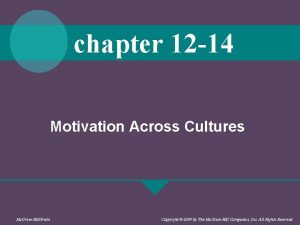Time Across Cultures Shao Guangqing Outline Time Attitudes










- Slides: 10

Time Across Cultures Shao Guangqing

Outline • Time • Attitudes to: Sequential and Synchronic ▫ Sequential ▫ Synchronic • Sequential cultures Vs Synchronic cultures • Conclusion

Time • Time is one of the most precious commodities in today’s modern world, however the value we give to time and how we manage our day by it is not universal. • Many professionals working across cultures are surprised by how their international counterparts manage meetings, projects or other business activities. • Different interpretations of being ‘on time’, the importance placed on deadlines and how people refer to the past, present or future are just some aspects of how time can be perceived differently across cultures.

Time • Working effectively across cultures requires an awareness of different perceptions of time which will help to reduce the complexity of international business and put you in a better position to manage and harness cultural differences.

Attitudes to: Sequential and Synchronic • There are so many components of time that need to be understood when working across cultures that it can become quite confusing. • Dutch interculturalist Fons Trompenaars suggests a simple model which puts attitudes to time into two general categories: sequential and synchronic. • With these terms Trompenaars attempts to describe how people around the world generally manage their time and how time impacts on their behaviour and mindset.

Sequential • In sequential cultures Trompenaars argues that time is dealt with in a specific logical order. • For example people from a sequential culture may prefer to have a detailed agenda for meetings and regular milestones throughout the life cycle of a project. • Time tends to control and influence what people do in sequential cultures, and many will find value in the expression ‘time is money’.

Synchronic • In synchronic cultures people will have a much broader and more flexible perception of time. As such time is adaptable and allows much more freedom for tasks to be achieved. • People from synchronic cultures don’t tend to be slaves to time but rather they use time as a guidance for how they structure their day and life. • In synchronic cultures people will approach tasks in a much more open way and not be as beholden to deadlines and timeframes. Rescheduling a meeting at the last minute, showing up a few minutes after the meeting start time or missing an agreed deadline are all things they accept readily.

Sequential cultures Vs Synchronic cultures Sequential cultures Synchronic cultures People tend to do one thing at a time People tend to do multiple things at a time Times are precise and punctuality is valued Times and deadlines are guidelines that people may intend to meet but won’t always Time is limited – time is a resource that needs to be efficiently used Time is a tool, a subjective, mouldable concept Logic, efficiency and speed are the focus of business Relationships are the focus of business and will improve efficiency Tasks are sometimes secondary to time Sticking to time is secondary to building relationships Meeting deadlines is commended Completing the task well is more important than meeting deadlines The future is a continuation of the present The future is interconnected with the past and present

Sequential cultures Vs Synchronic cultures Sequential cultures Synchronic cultures Businesspeople give full attention to one agenda item after another. The flow of time is viewed as a sort of circle, with the past, present, and future all interrelated. This viewpoint influences how organizations in those cultures approach deadlines, strategic thinking, investments, developing talent from within, and the concept of "long-term" planning. North American, English, German, Swedish, and Dutch South America, southern Europe, Africa and Asia

Conclusion • The importance that people give to time can vary dramatically. Working effectively across cultures requires the ability to not only identify different perceptions of time, but it also requires the skills to be able to manage business and relationships when attitudes to time are so drastically different. • Whether you see time as money, something to be controlled or something that will guide you from one point to another, think about the above attitudes to time you may find and be aware of how you may be perceived by your international counterparts when working across cultures.



















